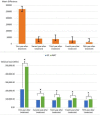Long-Term Medical Resource Consumption of Radical Prostatectomy vs. Intensity-Modulated Radiotherapy for Old Patients With Prostate Cancer: A Nationwide Population-Based Cohort Study
- PMID: 35592854
- PMCID: PMC9113182
- DOI: 10.3389/fmed.2022.843709
Long-Term Medical Resource Consumption of Radical Prostatectomy vs. Intensity-Modulated Radiotherapy for Old Patients With Prostate Cancer: A Nationwide Population-Based Cohort Study
Abstract
Purpose: Few studies have compared the long-term medical resource consumption between radical prostatectomy (RP) and intensity-modulated radiation therapy (IMRT) among old (≥80 years) patients with localized prostate cancer (LPC), particularly in those at high risk of prostate adenocarcinoma.
Patients and methods: The propensity score matching was conducted to investigate the medical expenditure of two therapeutic modalities (RP and IMRT) in elderly patients with high-risk LPC (HR-LPC). The generalized linear mixed and logistic regression models were employed to evaluate the number of postdischarge visits and medical reimbursement for urinary diseases or complications and the number of hospitalizations for treatment-related complications over 5 years after treatment, respectively.
Results: Significant differences were observed in the median or mean urology clinic visit numbers across the two therapeutic modalities from the first until fifth year post treatment (p < 0.0001). After adjustment for covariates, the mean difference [95% confidence interval (CI)] of urology clinic visit numbers between RP and IMRT was 13.07 (10.45-15.49, P < 0.0001), 7.47 (8.01-14.92, P < 0.0001), 8.24 (4.59-9.90, P < 0.0001), 6.63 (3.55-11.70, P < 0.0001), and 5.02 (1.12-8.73, P < 0.0001) for the first, second, third, fourth, and fifth years, respectively. In the logistic regression multivariate model with adjustment for covariates [therapy type, age, diagnosis year, income, hospital area, hospital level (academic or nonacademic), clinical and pathological T-stage, grade (Gleason score), pretreatment PSA level (ng/ml), and D'Amico risk classification], the adjusted odds ratio (95% CI) of IMRT was 2.10 (1.37-2.56, P = 0.0013), 1.55 (1.08-2.21, P = 0.0151), 1.35 (1.08-2.21, P = 0.0084), 1.24 (1.07-2.21, P = 0.0071), and 1.09 (1.02-1.81, P = 0.0379) for the first, second, third, fourth, and fifth years, respectively, compared with those of RP. The mean difference (95% CI) of total medical claims amounts of RP and IMRT between the RP and IMRT + ADT groups was 2,69,823 New Taiwan Dollars (NTD) (247,676-291,970, P < 0.0001), 40,803 NTD (17,379-54,228, P < 0.0001), 36,202 NTD (24,375-68,029, P < 0.0001), 26,708 NTD (11,179-54,595, P = 0.0321), and 12,173 NTD (17,140-41,487, P = 0.0187) for the first, second, third, fourth, and fifth years, respectively.
Conclusion: The long-term medical resource consumption was higher in old men with HR-LPC undergoing IMRT than in those undergoing RP.
Keywords: intensity-modulated radiation therapy; localized prostate cancer; medical resource consumption; old-age; radical prostatectomy.
Copyright © 2022 Wu, Effendi, Peng and Huang.
Conflict of interest statement
FE was employed by PT Inertia Utama. JP was employed by Roche Diagnostics Ltd. The remaining authors declare that the research was conducted in the absence of any commercial or financial relationships that could be construed as a potential conflict of interest.
Figures
Similar articles
-
Outcomes of treatment for localized prostate cancer in a single institution: comparison of radical prostatectomy and radiation therapy by propensity score matching analysis.World J Urol. 2020 Oct;38(10):2477-2484. doi: 10.1007/s00345-019-03056-3. Epub 2019 Dec 24. World J Urol. 2020. PMID: 31875247
-
Comparison of Clinical Outcomes of Radical Prostatectomy versus IMRT with Long-Term Hormone Therapy for Relatively Young Patients with High- to Very High-Risk Localized Prostate Cancer.Cancers (Basel). 2021 Nov 28;13(23):5986. doi: 10.3390/cancers13235986. Cancers (Basel). 2021. PMID: 34885096 Free PMC article.
-
Acute, Subchronic, and Chronic Complications of Radical Prostatectomy Versus Radiotherapy With Hormone Therapy in Older Adults With High-Risk Prostate Adenocarcinoma.Front Oncol. 2022 May 2;12:875036. doi: 10.3389/fonc.2022.875036. eCollection 2022. Front Oncol. 2022. PMID: 35586485 Free PMC article.
-
The Latest Data Specifically Focused on Long-Term Oncologic Prognostication for Very Old Adults with Acute Vulnerable Localized Prostate Cancer: A Nationwide Cohort Study.J Clin Med. 2022 Jun 15;11(12):3451. doi: 10.3390/jcm11123451. J Clin Med. 2022. PMID: 35743522 Free PMC article.
-
Intensity-modulated radiotherapy versus radical prostatectomy in patients with localized prostate cancer: long-term follow-up.BMC Cancer. 2013 Nov 8;13:530. doi: 10.1186/1471-2407-13-530. BMC Cancer. 2013. PMID: 24209381 Free PMC article.
Cited by
-
Radiation after radical prostatectomy in elderly patients - a SEER database-derived competing-risk survival analysis of propensity score-matched age groups.Cent European J Urol. 2023;76(4):293-299. doi: 10.5173/ceju.2023.144. Epub 2023 Nov 13. Cent European J Urol. 2023. PMID: 38230322 Free PMC article.
References
-
- Brandeis J, Pashos CL, Henning JM, Litwin MS. A nationwide charge comparison of the principal treatments for early stage prostate carcinoma. Cancer. (2000) 89:1792–99. - PubMed
-
- Oncology NCPGI . NCCN Clinical practice guidelines in oncology: Prostate Cancer [Online]. 94 N Woodhull Rd, Huntington, NY 11743: Harborside Press, LLC; (2021). Available online at: https://www.nccn.org/professionals/physician_gls/pdf/prostate.pdf (accessed Feburary 17, 2021).
LinkOut - more resources
Full Text Sources
Research Materials
Miscellaneous


